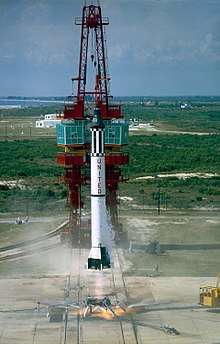Titan Missile Museum
The Titan Missile Museum, also known as Air Force Facility Missile Site 8 or as Titan II ICBM Site 571-7, is a former ICBM missile site located at 1580 West Duval Mine Road, Sahuarita, Arizona in the United States. It is located about 40 km (25 mi)[3] south of Tucson on I-19. It is now a museum run by the nonprofit Arizona Aerospace Foundation and includes an inert Titan II intercontinental ballistic missile in the silo, as well as the original launch facilities.
Air Force Facility Missile Site 8 (571-7) Military Reservation | |
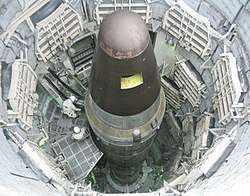 An ICBM loaded into the silo of the Titan Missile Museum, with a hole cut into the side of the nose cone to show that the weapon is inert. | |
  | |
| Location | 1580 West Duval Mine Road Sahuarita, Arizona |
|---|---|
| Coordinates | 31°54′10.9″N 110°59′54.29″W |
| Built | 1963 |
| Architect | Ralph M Parson Co. |
| NRHP reference No. | 92001234 |
| Significant dates | |
| Added to NRHP | December 3, 1992[1] |
| Designated NHL | April 19, 1994[2] |
It was declared a National Historic Landmark in 1994. It is the only surviving Titan II complex to survive from the late Cold War period.[2][4][5]
Underground facilities
The underground facilities consist of a three-level Launch Control Center, the eight level silo containing the missile and its related equipment, and the connecting structures of cableways (access tunnels), blast locks, and the access portal and equipment elevator. The complex was built of steel reinforced concrete with walls as much as 8-foot-thick (2.4 m) in some areas, and a number of 3-ton blast doors sealed the various areas from the surface and each other.
The top level of the silo permits viewing the silo missile doors. Level 3 houses a large diesel generator. Level 7 provides access to the lowest part of the launch duct. Visitors on the "Beyond the Blast Doors" tour are allowed to stand directly underneath the missile. Level 8, at 140 ft (43 m) underground, houses the propellant pumps.[6]
Titan II missile
The 103-foot (31 m) Titan II missile inside the silo has neither warhead nor fuel, allowing it to be safely displayed to visitors. In accordance with a US/USSR agreement, the silo doors are permanently blocked from opening more than half way. The dummy reentry vehicle mounted on the missile has a prominent hole cut in it to prove it is inert. All of the support facilities at the site remain intact, complete with all of their original equipment.
The silo became operational in 1963 and was deactivated in 1984 as part of President Reagan's policy (announced in 1981) of decommissioning the Titan II missiles as part of a weapon systems modernization program. All operational Titan II silos throughout the country were demolished, including 18 sites around McConnell AFB in Wichita, Kansas, 17 sites near Little Rock AFB, Arkansas (one additional site previously damaged beyond repair in a mishap/non-nuclear explosion) and 17 other sites by Davis-Monthan AFB and Tucson with the exception of this one. It is now a National Historic Landmark.
Yield and warhead
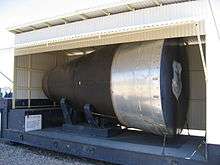
The Titan II was the largest operational land based nuclear missile ever used by the United States. The missile had one W53 warhead with a yield of 9 Megatons (9,000 kilotons).
The facility's highest state of alert was November 22, 1963, when President John F. Kennedy was shot. When news of the shooting broke, the keys used to launch the missile were ordered to be placed on the tables at the launch consoles to prepare for a possible launch. The Pentagon did not yet know whether the Soviet Union had committed an act of war. The keys were not, however, placed in their switches.
At launch, orders from the National Command Authority would have specified one of three pre-programmed targets which, for security reasons, were unknown to the crew. The missile base that is now the Titan Missile Museum (complex 571-7 of the 390th Strategic Missile Wing) was, at the time of closure, programmed to strike "Target Two". The missile's computer could hold up to three targets, and the target selected was determined by Strategic Air Command headquarters. To change the selected target, the crew commander pressed the appropriate button on the launch console. Target 2, which is classified to this day but was assumed to be within the borders of the former Soviet Union, was designated as a ground burst, suggesting that the target was a hardened facility such as a Soviet missile base. Targets could be selected for air or ground burst, but the selection was determined by Strategic Air Command.
Tourist Attractions


A visitor center for the site features a gift shop, a small museum and guided tours of the site. The museum is intended to put the Titan II within the context of the Cold War. Paid tours are available for hire, offering education about the history of the Titan II site and program, as well as a closer look at many features of the complex. Relics include hardstands for fuel storage containers and the associated control vehicles, restored engines from a Titan II missile, and a re-entry vehicle.
Tours below ground may include the control room, the cableways (tunnels), the silo, antenna tower and more. More information can be found and reservations may be made via the museum web site. Several times each month a more extensive "top to bottom" tour is available. This tour takes up to 5 hours and accommodates a maximum of six people. Prior reservations required. The top-to-bottom tour is not handicapped accessible.
Several scenes in the 1996 film Star Trek: First Contact were shot at the site. The missile itself was depicted as the launch vehicle for the film's Phoenix spacecraft, the first warp prototype.
Gallery
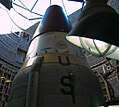 Warhead stage at top of missile in silo
Warhead stage at top of missile in silo Side of missile in silo
Side of missile in silo Launch control center equipment
Launch control center equipment Long cableway
Long cableway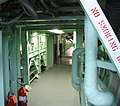 Short cableway
Short cableway Missile first stage engine on grounds of the museum
Missile first stage engine on grounds of the museum
See also
- Minuteman Missile National Historic Site
- Strategic missile forces museum in Ukraine - Similar museum in the former Soviet Union
References
- "National Register Information System". National Register of Historic Places. National Park Service. January 23, 2007.
- "Air Force Facility Missile Site 8". National Historic Landmark summary listing. National Park Service. 2007-09-27.
- "Driving Directions". Retrieved 2014-05-06.
- "USDI/NPS NRHP Registration Form (Rev. 8-86): Air Force Facility Site 8 (571-7)" (PDF). National Historic Landmark Nomination. National Park Service. September 1993. Retrieved 2009-05-02.
- "Air Force Facility Site 8--Accompanying 8 photos, 1 aerial, 7 exterior and interior from 1992" (PDF). National Historic Landmark Nomination. National Park Service. September 1993. Retrieved 2009-05-02.
- "Titan Missile Museum". Arizona Aerospace Foundation. 2007. Retrieved October 24, 2007.
External links
| Wikimedia Commons has media related to Titan Missile Museum. |
